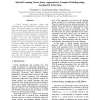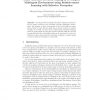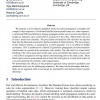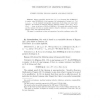2750 search results - page 21 / 550 » The complexity of learning SUBSEQ(A) |
JKM
2008
13 years 7 months ago
2008
Purpose
ICTAI
2005
IEEE
14 years 1 months ago
2005
IEEE
A hybrid learning neuro-fuzzy system with asymmetric fuzzy sets (HLNFS-A) is proposed in this paper. The learning methods of random optimization (RO) and least square estimation (...
AI
2004
Springer
14 years 25 days ago
2004
Springer
Abstract. Choosing between multiple alternative tasks is a hard problem for agents evolving in an uncertain real-time multiagent environment. An example of such environment is the ...
BMVC
2010
13 years 5 months ago
2010
We propose a novel directed graphical model for label propagation in lengthy and complex video sequences. Given hand-labelled start and end frames of a video sequence, a variation...
ECCC
2008
13 years 7 months ago
2008
Higman essentially showed that if A is any language then SUBSEQ(A) is regular, where SUBSEQ(A) is the language of all subsequences of strings in A. Let s1, s2, s3, . . . be the sta...




